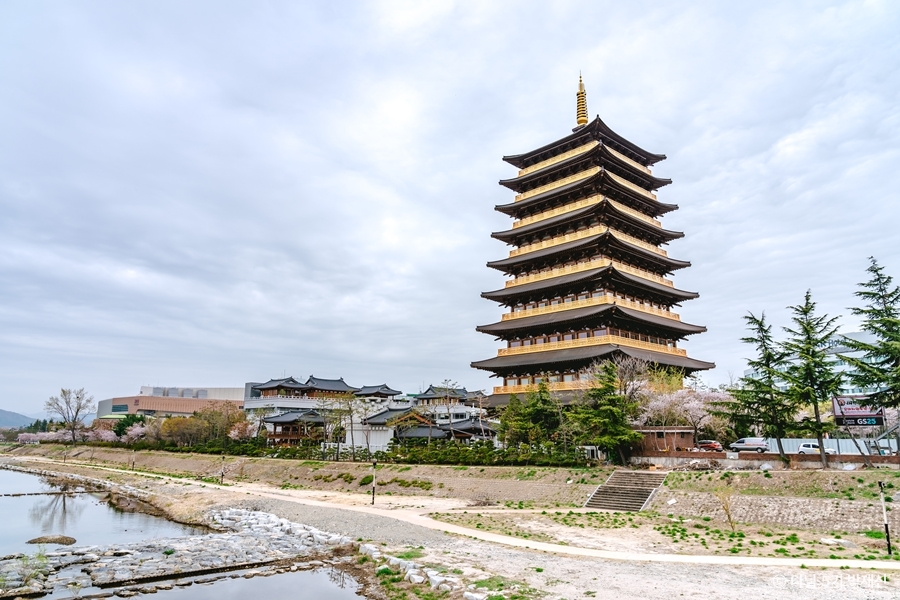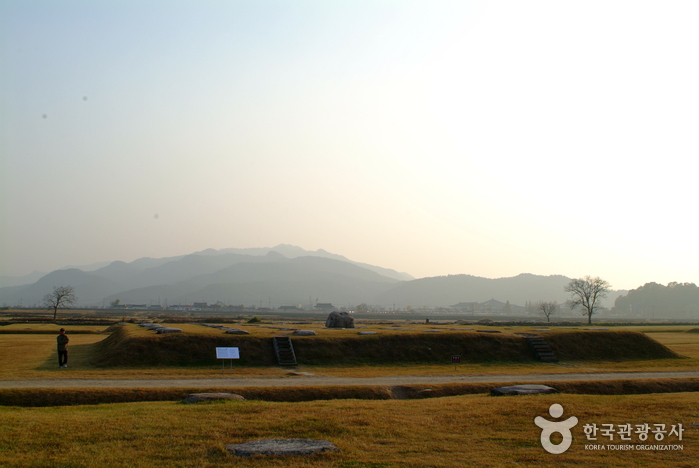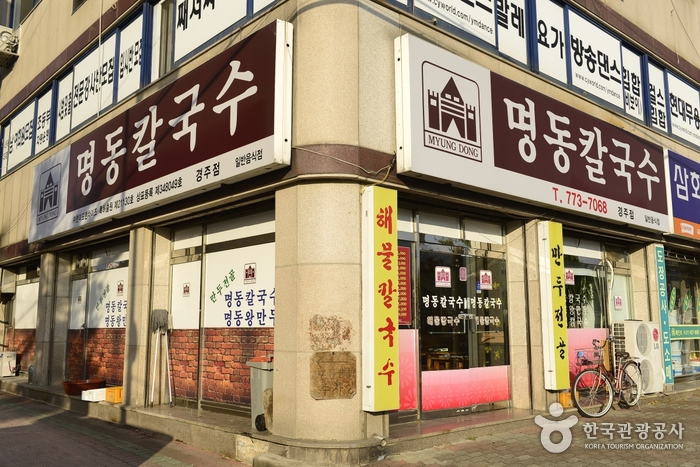BENIKEA Swiss Rosen Hotel Gyeongju (베니키아 스위스로젠 호텔 (경주))
3.8Km 2019-11-04
465-47, Bomun-ro, Gyeongju-si, Gyeongsangbuk-do
+82-54-748-4848
Swiss Rosen Hotel, located inside Gyeongju Bomun Complex, boasts sophisticated interior design and cozy guestrooms. Also, in addition to free services such as Wi-fi Internet, bike rentals, outdoor movie screening, and guest pick-up, the hotel offers easy access to several exciting adventures on the nearby Bomun Resort, including horseback riding, hiking trails, golf courses and Bomun Lake.
Hwang Nyong Won (황룡원)
3.9Km 2025-03-14
40 Expo-ro, Gyeongju-si, Gyeongsangbuk-do
+82-54-760-0500
This unique architecture is a reinterpretation of the Hwangnyongsa nine-story pagoda format from the Silla period using modern science technology and architecture methods. The building has become a new landmark in Bomun Tourist Complex and is also used as a training institute that offers meditation programs. There are simple one-hour programs or overnight tour courses available through prior reservation.
Gyeongju Hwangnyongsa Temple Site (경주 황룡사지)
4.1Km 2021-01-29
64-19, Imhae-ro, Gyeongju-si, Gyeongsangbuk-do
+82-54-779-6100
Hwangnyongsa Temple Site is located in front of Bunhwangsa Temple in Guhang-dong, Gyeongju. During the Silla Era, the Hwangnyongsa Temple was the nation’s largest temple and housed the bulk of the country’s major Buddhist treasures.
Construction of the temple began in 553 on a field east of the royal compound under the commission of King Jinheung. The king originally planned to build a palace, but decided to build a temple instead, after receiving reports that a yellow dragon had been spotted on the building site. The temple was thus named Hwangnyongsa (Temple of Yellow Dragon) and was completed in 569, seventeen years after construction began. The temple murals featured an old pine tree drawn by Artist Solgeo. During the Silla Era, the temple was the center of state-sanctioned Buddhism.
Later, when monk Jajang was studying in China during the Tang dynasty, he came across a god as he was passing by Taihe Pond. The god said to him, “The yellow dragon, which is my eldest son, is guarding Hwangnyongsa Temple upon orders of Brahma, the Creator. If you build a nine-story pagoda upon your return to Silla, the neighboring states will surrender and pay tribute, and the royal cause will be stronger. Once the construction of the pagoda is complete, prepare a memorial service for the local gods and pardon any of the country's criminals. If you follow all I have told you, no other state will dare invade Silla.”
After this encounter, Jajang returned to Silla and convinced Queen Seondeok to build the nine-story pagoda. Master architect Abiji of the neighboring state Baekje designed the pagoda and the project was built by Yongchun and 200 men using wood and stone. The night before the columns were to be erected, Architect Abiji of Baekje dreamed of the fall of Baekje and refused to complete the project. With a peal of thunder, an old monk and a man of great strength suddenly appeared from the temple's main hall, erected the columns, and magically disappeared. Abiji was so shocked at the sight that he accepted his country’s future demise as the fate of the gods and once again restarted work on the temple. (From Samgungnyusa, the Memorabilia of the Three Kingdoms)
In the twenty-three years following the completion of the pagoda, Queen Seondeok unified the Three Kingdoms; later, numerous scholars pointed to the pagoda as a contributing factor in the unification. Of the three treasures of Silla, two were located at Hwangnyongsa Temple. The largest bell of Silla was also in the temple, but was taken away during the Mongol invasion. The highest monks of Silla preached at the temple, and many kings came to listen to the Buddhist teachings.
During excavation work in July 1969, the massive foundation stones of the sermon hall, auditorium, and pagoda were found. Eight years of archaeological excavations and studies revealed the unique layout of the temple grounds, which consisted of one pagoda and three halls; also found were 40,000 or so ancient artifacts. Though foundation stones and other structures from the bottom of the temple were identified through excavation, there are no historical clues about the temple’s upper design, making the restoration of the temple in its entirety practically impossible. The size of the temple, based on archeological findings, was about 70 acres, roughly eight times larger than that of Bulguksa Temple.
Gyeongju Expo Solgeo Art Museum (경주솔거미술관(솔거미술관))
4.1Km 2025-05-19
614 Gyeonggam-ro, Gyeongju-si, Gyeongsangbuk-do
Gyeongju Expo Solgeo Art Museum is Gyeongju’s first public art museum, opened in 2015 with the donation of 830 works by the Korean painter Park Dae-sung. Designed by the renowned architect Seung H-Sang, the museum’s architecture blends people, space, and nature. It features a permanent exhibition of works by Park Dae-sung, along with special rotational exhibitions by invited artists. For visitors seeking deeper insight into the artwork, the museum offers a docent program. The window in the permanent exhibition hall has become a popular SNS spot and is often referred to as a moving painting.
Salon Heritage (살롱헤리티지)
4.1Km 2025-05-26
614 Gyeonggam-ro, Gyeongju-si, Gyeongsangbuk-do
Salon Heritage is a world cultural heritage media promotion hall, located inside the Gyeongju World Expo Memorial, which was designed by renowned architect Kengo Kuma, drawing inspiration from Daereungwon Ancient Tombs and columnar joints of Gyeongju. It features dynamic media walls, a media tunnel and a world heritage study, offering visitors an immersive digital experience to explore the rich heritage of Gyeongju.
Myeongdong Kalguksu (명동칼국수)
4.2Km 2024-02-28
46-4 Yongdam-ro, Gyeongju-si, Gyeongsangbuk-do
Myeongdong Kalguksu is a noodle restaurant specializing in kalguksu (noodle soup), located near Gyeongju Hwangseong Park. It offers kalguksu, haemul kalguksu (noodle soup with seafood), mandu jeongol (mandu hot pot), and more, prepared with chewy noodles and rich anchovy broth. After your meal, you can explore nearby attractions such as Gyeongju Civic Stadium, Arts Center, and Bitnuri Garden, as this area is rich in the cultural and historical heritage of the Silla dynasty.
Hanok Stay Joadang [Korea Quality] 한옥스테이 조아당[한국관광 품질인증]
4.2Km 2025-03-24
11 Wonhyo-ro 213beon-gil, Gyeongju-si, Gyeongsangbuk-do
+82-10-6520-5074
Joadang is a private hanok stay on Wonhyoro-gil, Gyeongju, Gyeongsangbuk-do. The inside of this traditional hanok is finished with cypresswood, and guests can catch the scent of cypress and feel refreshed. There are two guestrooms, both with a queen-size bed, and one with its own bathroom. The location is great for walking and for seeing the sights of Gyeongju.
Gyeongju Expo Park (경주엑스포공원)
4.3Km 2024-11-11
614 Gyeonggam-ro, Gyeongju-si, Gyeongsangbuk-do
Gyeongju Expo Park is located in the Bomun Tourist Complex in Gyeongju, offering a thematic experience of Korean culture through exhibitions, performances, and hands-on activities showcasing the art and culture of the Silla dynasty (BC 57-AD 935). The park features various attractions such as Gyeongju Tower, Timeless Media Art, Solgeo Art Museum, Lumina Night Walk, Cheomseongdae Film Hall, and Asadal Sculpture Park.
Hwangseong Park (황성공원)
4.3Km 2025-06-19
431-12 Wonhwa-ro, Gyeongju-si, Gyeongsangbuk-do
Situated near the Gyeongju Municipal Library and Gyeongju Arena, Hwangseong Park is notable for its dense forest populated with stunning pine trees and centuries-old trees. During summer, it becomes a haven for blooming Lilyturfs, while in autumn, ancient trees such as zelkova and oak showcase vibrant colors, enhancing the natural beauty of the area. Within the park, visitors can find the Statue of General Kim Yusin, a Korean archery range, and a Ssireum (Korean traditional wrestling) ring. Nearby attractions include Gyeongjueupseong Walled Town, Cheonmachong Tomb, Daereungwon Ancient Tombs, and Hwangnidan Street.




![Hanok Stay Joadang [Korea Quality] 한옥스테이 조아당[한국관광 품질인증]](http://tong.visitkorea.or.kr/cms/resource/08/3009408_image2_1.jpg)
 English
English
 한국어
한국어 日本語
日本語 中文(简体)
中文(简体) Deutsch
Deutsch Français
Français Español
Español Русский
Русский